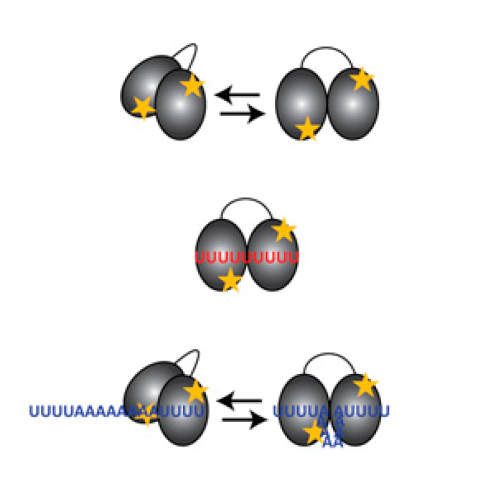Recognition of the 3′ splice site RNA by the U2AF heterodimer involves a dynamic population shift
31-Oct-2016
PNAS, doi: 10.1073/pnas.1605873113
PNAS, online article
An essential early step in the assembly of human spliceosomes onto pre-mRNA involves the recognition of regulatory RNA cis elements in the 3′ splice site by the U2 auxiliary factor (U2AF). The large (U2AF65) and small (U2AF35) subunits of the U2AF heterodimer contact the polypyrimidine tract (Py-tract) and the AG-dinucleotide, respectively. The tandem RNA recognition motif domains (RRM1,2) of U2AF65 adopt closed/inactive and open/active conformations in the free form and when bound to bona fide Py-tract RNA ligands. To investigate the molecular mechanism and dynamics of 3′ splice site recognition by U2AF65 and the role of U2AF35 in the U2AF heterodimer, we have combined single-pair FRET and NMR experiments. In the absence of RNA, the RRM1,2 domain arrangement is highly dynamic on a submillisecond time scale, switching between closed and open conformations. The addition of Py-tract RNA ligands with increasing binding affinity (strength) gradually shifts the equilibrium toward an open conformation. Notably, the protein–RNA complex is rigid in the presence of a strong Py-tract but exhibits internal motion with weak Py-tracts. Surprisingly, the presence of U2AF35, whose UHM domain interacts with U2AF65 RRM1, increases the population of the open arrangement of U2AF65 RRM1,2 in the absence and presence of a weak Py-tract. These data indicate that the U2AF heterodimer promotes spliceosome assembly by a dynamic population shift toward the open conformation of U2AF65 to facilitate the recognition of weak Py-tracts at the 3′ splice site. The structure and RNA binding of the heterodimer was unaffected by cancer-linked myelodysplastic syndrome mutants.











